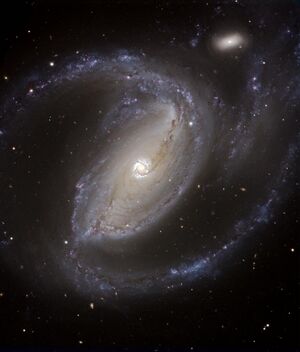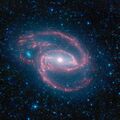Astronomy:NGC 1097
| NGC 1097 | |
|---|---|
 NGC 1097 as taken from VLT | |
| Observation data (J2000 epoch) | |
| Constellation | Fornax |
| Right ascension | 02h 46m 19.0s[1] |
| Declination | −30° 16′ 30″[1] |
| Redshift | 1271 ± 3 km/s[1] |
| Distance | 45 million ly[2] |
| Apparent magnitude (V) | 10.2[1] |
| Characteristics | |
| Type | (R'_1:)SB(r'l)bSy1[1] |
| Apparent size (V) | 9.3′ × 6.3′[1] |
| Other designations | |
| ESO 416- G 20, PGC 10488, UGCA 041[1] Arp 77[1] Caldwell 67 | |
NGC 1097 (also known as Caldwell 67) is a barred spiral galaxy about 45 million light years away in the constellation Fornax. It was discovered by William Herschel on 9 October 1790. It is a severely interacting galaxy with obvious tidal debris and distortions caused by interaction with the companion galaxy NGC 1097A.[3]
Four supernovae have been observed in NGC 1097: SN 1992bd (type II, mag. 15), SN 1999eu (type II-pec, mag. 19.7), SN 2003B (type II, mag. 17.6),[4] and SN 2023rve (type II, mag. 14).[5]
General information
NGC 1097 is also a Seyfert galaxy. Deep photographs revealed four narrow optical jets that appear to emanate from the nucleus. These have been interpreted as manifestations of the (currently weak) active nucleus. Subsequent analysis of the brightest jet's radio-to-X-ray spectral energy distribution were able to rule out synchrotron and thermal free-free emission. The optical jets are in fact composed of stars. The failure to detect atomic hydrogen gas in the jets (under the assumption that they were an example of tidal tails) using deep 21 cm HI imaging with the Very Large Array radio telescope and numerical simulations led to the current interpretation that the jets are actually the shattered remains of a cannibalized dwarf galaxy.
NGC 1097 has a supermassive black hole at its center, which is 140 million times the mass of the Sun.[6][7] Around the central black hole is a glowing ring of star-forming regions with a network of gas and dust that spirals from the ring to the black hole. An inflow of material toward the central bar of the galaxy causes new stars to be created in the ring. The ring is approximately 5,000 light-years in diameter, the spiral arms of the galaxy extend tens of thousands of light-years beyond the ring.[6]
NGC 1097 has two satellite galaxies, NGC 1097A and NGC 1097B. Dwarf elliptical galaxy NGC 1097A is the larger of the two. It is a peculiar elliptical galaxy that orbits 42,000 light-years from the center of NGC 1097. Dwarf galaxy NGC 1097B (5 x 106 solar masses), the outermost one, was discovered by its HI emission, and appears to be a typical dwarf irregular. Little else is known about it.
Central region, Hubble Space Telescope
Ring of star birth, and dust, gas and debris from the galaxy, which are being funneled into the supermassive black hole at its centre. Hubble Space Telescope, 2004
… and with 8 meter diameter Very Large Telescope and adaptive optic, 2022
See also
- NGC 1300, a barred spiral galaxy
- NGC 1232, an intermediate spiral galaxy
- NGC 7479, another example of a barred spiral galaxy
References
- ↑ 1.0 1.1 1.2 1.3 1.4 1.5 1.6 1.7 "NASA/IPAC Extragalactic Database". Results for NGC 1097. http://nedwww.ipac.caltech.edu/.
- ↑ "Feeding the Monster: New VLT Images Reveal the Surroundings of a Super-massive Black Hole". European Southern Observatory. http://www.eso.org/public/outreach/press-rel/pr-2005/phot-33-05.html.
- ↑ Buta, Ronald J; Corwin, Harold G; Odewahn, Stephen C (2007). The de Vaucouleurs Atlas of Galaxies. Cambridge University Press. p. 193. ISBN 978-0-521-82048-6. https://books.google.com/books?id=g-P7dCbB5MEC&pg=PA193.
- ↑ Harrington, Philip S. (2010). Cosmic Challenge: The Ultimate Observing List for Amateurs. Cambridge, United Kingdom: Cambridge University Press. pp. 351. ISBN 978-1-139-49368-0. https://books.google.com/books?id=8mQmvT4wpWQC&pg=PA351.
- ↑ Odeh, Mohammad (8 September 2023). "AT 2023rve". IAU Supernova Working Group. https://www.wis-tns.org/object/2023rve.
- ↑ 6.0 6.1 "Astronomers Measure Mass of Supermassive Black Hole in NGC 1097 | Astronomy | Sci-News.com". http://www.sci-news.com/astronomy/science-supermassive-black-hole-ngc1097-02928.html.
- ↑ Onishi, K.; Iguchi, S.; Sheth, K.; Kohno, K. (2015-06-10). "A Measurement of the Black Hole Mass in NGC 1097 Using ALMA". The Astrophysical Journal 806 (1): 39. doi:10.1088/0004-637X/806/1/39. ISSN 0004-637X. Bibcode: 2015ApJ...806...39O.
External links
- VLT observations – NGC 1097's "dog-leg" tidal stream
- weblore.com – NGC 1097: The Galaxy with the Longest known Optical Jets
- Antilhue-Chile – NGC 1097 in Fornax
- ESO – Very Large Telescope observations of NGC 1097
- Astronomy Picture of the Day – In the Arms of NGC 1097 (2006-12-01)
- The dance of stars and space, 29 December 2012, Thomas Anderson, TG Daily
- NGC 1097 on WikiSky: DSS2, SDSS, GALEX, IRAS, Hydrogen α, X-Ray, Astrophoto, Sky Map, Articles and images
Coordinates: ![]() 02h 46m 19.0s, −30° 16′ 30″
02h 46m 19.0s, −30° 16′ 30″
 |






